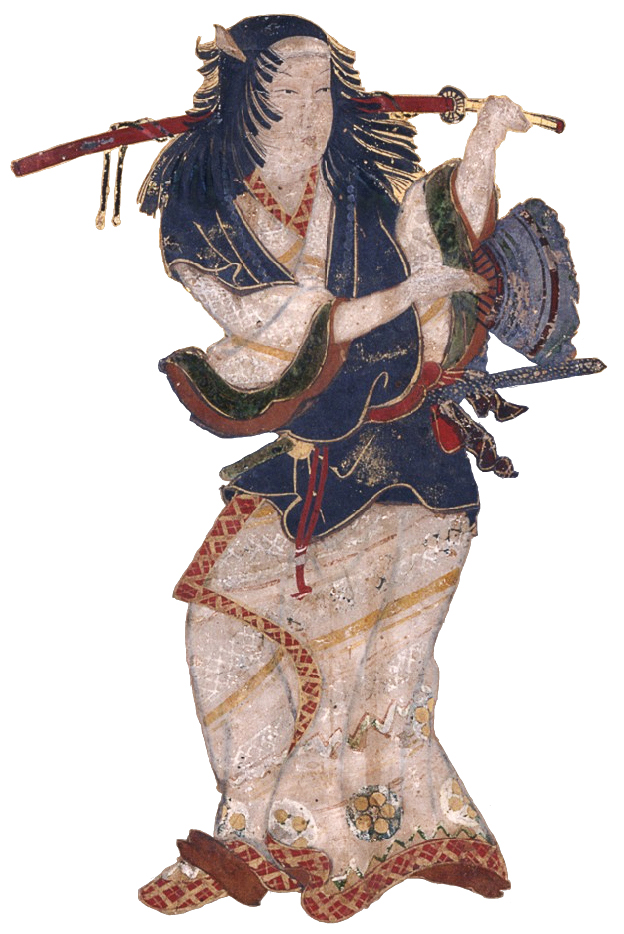|
Namiki Shōzō I
Namiki Shōzō I (並木正三) (1730–1773) was a prominent Japanese playwright who produced roughly 100 works for ''bunraku'' (puppet theater) and for ''kabuki''. Shōzō is also credited with inventing the revolving stage (回り舞台, ''mawaributai''), one of many tricks of stagecraft used extensively in ''kabuki'', and with popularizing the use of trapdoors (セリ上げ, ''seriage''). Shōzō left ''bunraku'' in 1751; adapting plays from ''bunraku'' to ''kabuki'' was a very common practice, and it is likely that many of Shōzō's kabuki plays began as puppet productions. His roughly one hundred plays were mostly '' jidai-mono'' (時代物, historical plays), and include ''Keisei ama no hagoromo'' (The Feathery Garment from Heaven, 1753), ''Sanjikkoku yobune no hajimari'' (The Beginning of the Heavy Cargo Ships on the Yodo River, 1758), and ''Sanzen-sekai yarikuri ōrai'' (Kin'emon the Notorious Pirate, 1772). References *Takaya, Ted T. (1985). "Namiki Shōzō." Kodansha E ... [...More Info...] [...Related Items...] OR: [Wikipedia] [Google] [Baidu] |
Bunraku
is a form of traditional Japanese puppet theatre, founded in Osaka in the beginning of the 17th century, which is still performed in the modern day. Three kinds of performers take part in a performance: the or (puppeteers), the (chanters), and musicians. Occasionally other instruments such as drums will be used. The combination of chanting and playing is called and the Japanese word for puppet (or dolls, generally) is . It is used in many plays. History 's history goes as far back as the 16th century, but the origins of its modern form can be traced to around the 1680s. It rose to popularity after the playwright Chikamatsu Monzaemon (1653–1724) began a collaboration with the chanter Takemoto Gidayu (1651–1714), who established the Takemoto puppet theater in Osaka in 1684. Originally, the term referred only to the particular theater established in 1805 in Osaka, which was named the after the puppeteering ensemble of , an early 18th-century puppeteer from Awaji ... [...More Info...] [...Related Items...] OR: [Wikipedia] [Google] [Baidu] |
Kabuki
is a classical form of Theatre of Japan, Japanese theatre, mixing dramatic performance with Japanese traditional dance, traditional dance. Kabuki theatre is known for its heavily stylised performances, its glamorous, highly decorated costumes, and for the elaborate make-up worn by some of its performers. Kabuki is thought to have originated in the early Edo period, when the art's founder, Izumo no Okuni, formed a female dance troupe that performed dances and light sketches in Kyoto. The art form later developed into its present all-male theatrical form after women were banned from performing in kabuki theatre in 1629. Kabuki developed throughout the late 17th century and reached its zenith in the mid-18th century. In 2005, kabuki theatre was proclaimed by UNESCO as an intangible heritage possessing outstanding universal value. In 2008, it was inscribed in the UNESCO Intangible Cultural Heritage Lists, UNESCO Representative List of the Intangible Cultural Heritage of Humanity ... [...More Info...] [...Related Items...] OR: [Wikipedia] [Google] [Baidu] |
Keren (kabuki)
are stagecraft tricks used in Japanese kabuki theater, making use of trapdoor A trapdoor or hatch is a sliding or hinged door that is flush with the surface of a floor, ceiling, or roof. It is traditionally small in size. It was invented to facilitate the hoisting of grain up through mills, however, its list of uses has ...s, revolving stages, and other equipment. Often translated as "playing to the gallery," drama enthusiasts consider these sorts of adaptations to be demeaning to the art of kabuki. According to one scholar, Ichikawa Ennosuke, "Rapid 'trick' appearances and disappearances of the actor are relatively few and are held in low esteem by the Kabuki connoisseur, who refers to them as keren (playing to the gallery)". Primary forms of See also * Wazuma References {{DEFAULTSORT:Keren Kabuki Stagecraft Japanese words and phrases ... [...More Info...] [...Related Items...] OR: [Wikipedia] [Google] [Baidu] |
Jidai-mono
are Japanese kabuki or plays that feature historical plots and characters, often famous samurai battles. These are in contrast to , contemporary plays, which generally focus on commoners and domestic issues. is usually translated as "period plays". Film and television productions in this mode are called , and share many of the same features. Overview As the stereotypical audience for and kabuki were the merchant classes () of Edo period Japan, stories involving court nobles and heroic samurai were somewhat far removed from daily life, and the more everyday stories that dealt with contemporary, urban themes. Even though many of the viewers may have been samurai, the Edo period in which these plays were largely composed and performed was a period of peace, and so the notion of fierce battles and heroic sacrifices represented something of a romanticised escape in fiction. Stories were almost always derived from classic epics () or other historical sources, often with elements cha ... [...More Info...] [...Related Items...] OR: [Wikipedia] [Google] [Baidu] |
Namiki Shōzō II
Namiki Shōzō II (並木正三) (died 1807) was a ''kabuki'' playwright and relative of the more prominent Namiki Shōzō I. Though none of his surviving plays are prominent ones, he may have been the author of the 1801 '' Kezairoku'' (or ''Gezairoku''), a kabuki playwriting manual. References *Takaya, Ted T. (1985). "Namiki Shōzō." Kodansha Encyclopedia of Japan. Tokyo: Kodansha Ltd. Kabuki playwrights 1807 deaths Year of birth missing Japanese dramatists and playwrights Writers of the Edo period 18th-century Japanese dramatists and playwrights 19th-century Japanese dramatists and playwrights 18th-century Japanese people {{Japan-writer-stub ... [...More Info...] [...Related Items...] OR: [Wikipedia] [Google] [Baidu] |
Kabuki Playwrights
is a classical form of Japanese theatre, mixing dramatic performance with traditional dance. Kabuki theatre is known for its heavily stylised performances, its glamorous, highly decorated costumes, and for the elaborate make-up worn by some of its performers. Kabuki is thought to have originated in the early Edo period, when the art's founder, Izumo no Okuni, formed a female dance troupe that performed dances and light sketches in Kyoto. The art form later developed into its present all-male theatrical form after women were banned from performing in kabuki theatre in 1629. Kabuki developed throughout the late 17th century and reached its zenith in the mid-18th century. In 2005, kabuki theatre was proclaimed by UNESCO as an intangible heritage possessing outstanding universal value. In 2008, it was inscribed in the UNESCO Representative List of the Intangible Cultural Heritage of Humanity. Etymology The individual kanji that make up the word ''kabuki'' can be read as , , ... [...More Info...] [...Related Items...] OR: [Wikipedia] [Google] [Baidu] |
Bunraku
is a form of traditional Japanese puppet theatre, founded in Osaka in the beginning of the 17th century, which is still performed in the modern day. Three kinds of performers take part in a performance: the or (puppeteers), the (chanters), and musicians. Occasionally other instruments such as drums will be used. The combination of chanting and playing is called and the Japanese word for puppet (or dolls, generally) is . It is used in many plays. History 's history goes as far back as the 16th century, but the origins of its modern form can be traced to around the 1680s. It rose to popularity after the playwright Chikamatsu Monzaemon (1653–1724) began a collaboration with the chanter Takemoto Gidayu (1651–1714), who established the Takemoto puppet theater in Osaka in 1684. Originally, the term referred only to the particular theater established in 1805 in Osaka, which was named the after the puppeteering ensemble of , an early 18th-century puppeteer from Awaji ... [...More Info...] [...Related Items...] OR: [Wikipedia] [Google] [Baidu] |
1730 Births
Events January–March * January 30 (January 19 O.S.) – At dawn, Emperor Peter II of Russia dies of smallpox, aged 14 in Moscow, on the eve of his projected marriage. * February 26 (February 15 O.S.) – Anna of Russia (Anna Ioannovna) becomes reigning Empress of Russia following the death of her cousin Emperor Peter II. * February 28 – Vitus Bering returns to the Russian capital of Saint Petersburg after completing the First Kamchatka expedition. * March 5 – The 1730 papal conclave to elect a new Pope for the Roman Catholic church begins with 30 Cardinals, 12 days after the death of Pope Benedict XIII. By the time his successor is elected on July 12, there are 56 Cardinals. * March 9 – General Nader Khan of Persia opens the first campaign of the Ottoman–Persian War (1730–1735), guiding the Persian Army from Shiraz and starting the Western Persia Campaign against the Ottoman Empire. * March 12 – John Glas is deposed from ... [...More Info...] [...Related Items...] OR: [Wikipedia] [Google] [Baidu] |
1773 Deaths
Events January–March * January 1 – The hymn that becomes known as '' Amazing Grace'', at this time titled "1 Chronicles 17:16–17", is first used to accompany a sermon led by curate John Newton in the town of Olney, Buckinghamshire, England. * January 12 – The first museum in the American colonies is established in Charleston, South Carolina; in 1915, it is formally incorporated as the Charleston Museum. * January 17 – Second voyage of James Cook: Captain Cook in HMS Resolution (1771) becomes the first European explorer to cross the Antarctic Circle. * January 18 – The first opera performance in the Swedish language, ''Thetis and Phelée'', performed by Carl Stenborg and Elisabeth Olin in Bollhuset in Stockholm, Sweden, marks the establishment of the Royal Swedish Opera. * February 8 – The Grand Council of Poland meets in Warsaw, summoned by a circular letter from King Stanisław August Poniatowski to respond to the Kingdom's ... [...More Info...] [...Related Items...] OR: [Wikipedia] [Google] [Baidu] |
18th-century Japanese Dramatists And Playwrights
The 18th century lasted from 1 January 1701 (represented by the Roman numerals MDCCI) to 31 December 1800 (MDCCC). During the 18th century, elements of Enlightenment thinking culminated in the Atlantic Revolutions. Revolutions began to challenge the legitimacy of monarchical and aristocratic power structures. The Industrial Revolution began mid-century, leading to radical changes in human society and the environment. The European colonization of the Americas and other parts of the world intensified and associated mass migrations of people grew in size as part of the Age of Sail. During the century, slave trading expanded across the shores of the Atlantic Ocean, while declining in Russia and China. Western historians have occasionally defined the 18th century otherwise for the purposes of their work. For example, the "short" 18th century may be defined as 1715–1789, denoting the period of time between the death of Louis XIV of France and the start of the French Revolution, ... [...More Info...] [...Related Items...] OR: [Wikipedia] [Google] [Baidu] |





